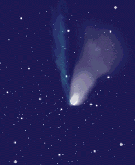How Sublime
 Show of hands. How many of you can't resist playing with dry ice? Dry ice is carbon dioxide frozen to -109.3 degrees F (-78.5 C). Throw a piece in water and it bubbles and boils. Expose a piece to air and it turns into white fog. The thing that makes dry ice do these tricks is a process called sublimation.
Show of hands. How many of you can't resist playing with dry ice? Dry ice is carbon dioxide frozen to -109.3 degrees F (-78.5 C). Throw a piece in water and it bubbles and boils. Expose a piece to air and it turns into white fog. The thing that makes dry ice do these tricks is a process called sublimation.
When a solid changes directly to a gas, without first becoming a liquid, we say that it sublimates. At the right temperature, any solid will sublimate without enough pressure. On the surface of the Earth, H2O exists in all three states of matter, including the liquid state. Because there is enough air pressure pressing on the H2O, it can remain a liquid between 32 degrees and 212 degrees Fahrenheit ( 0 and 100 C). But CO2 needs a lot of pressure to form a liquid, about 1,000 pounds per square inch of pressure, much more than is found naturally on the surface of the Earth. So instead, it makes a quick jump from a solid state to a gaseous state. In space, with little or no pressure, (there is no gravity in outer space), sublimation is the rule and not the exception. You won't find any liquids on a trip to Pluto. Here on Earth, if you use dry ice, you won't get a big puddle on your floor, but you may get frostbitten.
About the Author
Gene Mascoli, JD
 Gene Mascoli is a founder and publisher of ScienceIQ.com. He holds a J.D. degree from the University of Santa Clara and a B.A. in English. In 1997 Gene launched ScienceMaster.com, an online science education portal where he brought together his love of writing with his interest in the sciences. Gene collaborated with David Gamon on the popular digital book
“The Internet Guide to NASA on the Net” and has also produced two popular science CD-ROMs on astronomy and space science.
Gene Mascoli is a founder and publisher of ScienceIQ.com. He holds a J.D. degree from the University of Santa Clara and a B.A. in English. In 1997 Gene launched ScienceMaster.com, an online science education portal where he brought together his love of writing with his interest in the sciences. Gene collaborated with David Gamon on the popular digital book
“The Internet Guide to NASA on the Net” and has also produced two popular science CD-ROMs on astronomy and space science.


